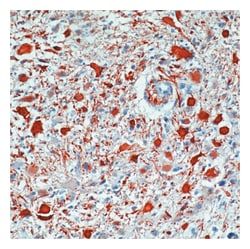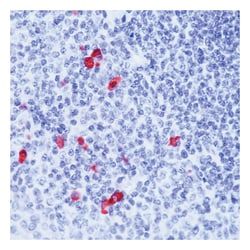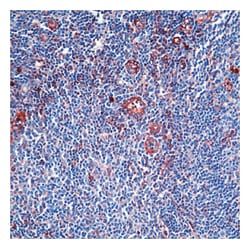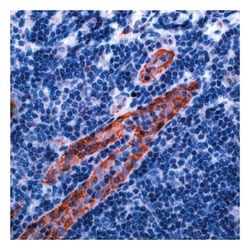RB087R7
GFAP (Glial Fibrillary Acidic Protein) Rabbit Polyclonal Antibody, Epredia™
Manufacturer: Fischer Scientific
Select a Size
| Pack Size | SKU | Availability | Price |
|---|---|---|---|
| Each of 1 | RB087R7-Each-of-1 | In Stock | ₹ 41,919.00 |
RB087R7 - Each of 1
In Stock
Quantity
1
Base Price: ₹ 41,919.00
GST (18%): ₹ 7,545.42
Total Price: ₹ 49,464.42
Antigen
GFAP (Glial Fibrillary Acidic Protein)
Classification
Polyclonal
Conjugate
Unconjugated
Immunogen
GFAP isolated from cow spinal cord
Regulatory Status
RUO
Primary or Secondary
Primary
Form
Prediluted
Applications
Immunohistochemistry (Paraffin)
Clone
Polyclonal
Host Species
Rabbit
Quantity
7 mL
Research Discipline
Neuroscience
Target Species
Bovine, Chicken, Guinea Pig, Hamster, Human, Mouse, Non-human Primate, Rat
Isotype
IgG
Related Products
Description
- Glial Fibrillary Acidic Protein (GFAP) is specific to astrocytes (i.e., glial cells) and ependymal cells of the central nervous system
- Host Species: Rabbit Isotype: IgG Species Reactivity: Human, Monkey, Cow, Sheep, Guinea Pig, Chicken, Mouse, Rat and Hamster
- Others not known
- Epitope: Not determined Immunogen: GFAP isolated from cow spinal cord Molecular Weight: 51-52 kDa Positive Control: Brain or astrocytoma Cellular Localization: Cytoplasmic Ab-4 stains astrocytes, glial cells, ependymal cells and their corresponding tumors
- In the peripheral nervous system, Schwann cells, satellite cells, and enteric glial cells are stained
- Weak staining of axons has been observed
- Absorption studies show that this is caused by a cross-reaction with neurofilament protein
- Ab-4 is particularly useful for distinguishing neoplasms of astrocytic origin from other neoplasms in the central nervous system by immunohistochemistry
- Recommended for: Immunohistochemistry (Formalin/paraffin) Note: USA: RUO; Int'l: RUO
Compare Similar Items
Show Difference
Antigen: GFAP (Glial Fibrillary Acidic Protein)
Classification: Polyclonal
Conjugate: Unconjugated
Immunogen: GFAP isolated from cow spinal cord
Regulatory Status: RUO
Primary or Secondary: Primary
Form: Prediluted
Applications: Immunohistochemistry (Paraffin)
Clone: Polyclonal
Host Species: Rabbit
Quantity: 7 mL
Research Discipline: Neuroscience
Target Species: Bovine, Chicken, Guinea Pig, Hamster, Human, Mouse, Non-human Primate, Rat
Isotype: IgG
Antigen:
GFAP (Glial Fibrillary Acidic Protein)
Classification:
Polyclonal
Conjugate:
Unconjugated
Immunogen:
GFAP isolated from cow spinal cord
Regulatory Status:
RUO
Primary or Secondary:
Primary
Form:
Prediluted
Applications:
Immunohistochemistry (Paraffin)
Clone:
Polyclonal
Host Species:
Rabbit
Quantity:
7 mL
Research Discipline:
Neuroscience
Target Species:
Bovine, Chicken, Guinea Pig, Hamster, Human, Mouse, Non-human Primate, Rat
Isotype:
IgG
Antigen: CD31 (Endothelial Cell Marker)
Classification: Polyclonal
Conjugate: Unconjugated
Immunogen: Synthetic peptide corresponding to C-terminus of mouse CD31 protein
Regulatory Status: RUO
Primary or Secondary: Primary
Form: Concentrated
Applications: Immunohistochemistry (Paraffin)
Clone: Polyclonal
Host Species: Rabbit
Quantity: 1 mL
Research Discipline: Cancer and Tumor Biology
Target Species: Human
Isotype: __
Antigen:
CD31 (Endothelial Cell Marker)
Classification:
Polyclonal
Conjugate:
Unconjugated
Immunogen:
Synthetic peptide corresponding to C-terminus of mouse CD31 protein
Regulatory Status:
RUO
Primary or Secondary:
Primary
Form:
Concentrated
Applications:
Immunohistochemistry (Paraffin)
Clone:
Polyclonal
Host Species:
Rabbit
Quantity:
1 mL
Research Discipline:
Cancer and Tumor Biology
Target Species:
Human
Isotype:
__
Antigen: CD31 (Endothelial Cell Marker)
Classification: Polyclonal
Conjugate: Unconjugated
Immunogen: Synthetic peptide corresponding to C-terminus of mouse CD31 protein
Regulatory Status: RUO
Primary or Secondary: Primary
Form: Concentrated
Applications: Immunohistochemistry (Paraffin)
Clone: __
Host Species: Rabbit
Quantity: 500 μL
Research Discipline: Cancer and Tumor Biology
Target Species: Human
Isotype: __
Antigen:
CD31 (Endothelial Cell Marker)
Classification:
Polyclonal
Conjugate:
Unconjugated
Immunogen:
Synthetic peptide corresponding to C-terminus of mouse CD31 protein
Regulatory Status:
RUO
Primary or Secondary:
Primary
Form:
Concentrated
Applications:
Immunohistochemistry (Paraffin)
Clone:
__
Host Species:
Rabbit
Quantity:
500 μL
Research Discipline:
Cancer and Tumor Biology
Target Species:
Human
Isotype:
__
Antigen: CD31 (Endothelial Cell Marker)
Classification: Polyclonal
Conjugate: Unconjugated
Immunogen: Synthetic peptide corresponding to C-terminus of mouse CD31 protein
Regulatory Status: RUO
Primary or Secondary: Primary
Form: Prediluted
Applications: Immunohistochemistry (Paraffin)
Clone: __
Host Species: Rabbit
Quantity: 1 mL
Research Discipline: Cancer and Tumor Biology
Target Species: Human
Isotype: __
Antigen:
CD31 (Endothelial Cell Marker)
Classification:
Polyclonal
Conjugate:
Unconjugated
Immunogen:
Synthetic peptide corresponding to C-terminus of mouse CD31 protein
Regulatory Status:
RUO
Primary or Secondary:
Primary
Form:
Prediluted
Applications:
Immunohistochemistry (Paraffin)
Clone:
__
Host Species:
Rabbit
Quantity:
1 mL
Research Discipline:
Cancer and Tumor Biology
Target Species:
Human
Isotype:
__




